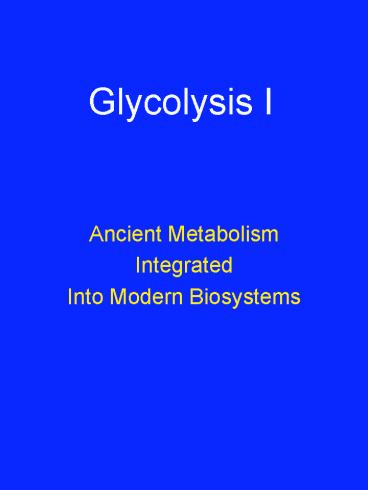Glycolysis I - PowerPoint PPT Presentation
1 / 22
Title:
Glycolysis I
Description:
Stoichiometry. Tissue differences. Glycolytic Functions. Carbohydrates are converted to fat ... Glycolysis provides intermediates to the hexose monophosphate shunt ... – PowerPoint PPT presentation
Number of Views:336
Avg rating:3.0/5.0
Title: Glycolysis I
1
Glycolysis I
- Ancient Metabolism
- Integrated
- Into Modern Biosystems
2
Main Features
- Oldest of Pathways
- Occurs in Soluble Phase of Cytoplasm (Cytosol)
- Anaerobic Phase of Energy Metabolism
- Generates ATP
- Produces Pyruvate/Lactate
- Produces Many Important Intermediates
3
Relationship to Other Pathways
- TCA Cycle
- Gluconeogenesis (in Liver and Kidney)
- Hexose Monophosphate Shunt (HMP)
- Metabolism of other Sugars, e.g., Fructose and
Galactose - Metabolism of Certain Amino Acids
- Lipid Metabolism
- Glycoprotein Synthesis
4
Pay Attention to These
- Steps involving ATP
- Oxidative Step (NADH)
- Step involving Pi
- Regulated Steps
- Stoichiometry
- Tissue differences
5
Glycolytic Functions
- Carbohydrates are converted to fat
- Glycogen is made
- Glycolysis provides intermediates to the hexose
monophosphate shunt - Glycolysis participates in the regulation of
oxygen transport by hemoglobin - Glycolysis and gluconeogenesis are involved with
alcohol metabolism
6
Typical Cell
Where are we going to be?
Peroxisome
Centriole
Mitochondrion
Rough ER
Smooth ER
Nucleus
Lysosome
Nucleolus
Plasma Membrane
Cytoskeleton
Golgi
Ribosomes
7
Glycolysis Simplified(anaerobic)
Glucose
2ADP
2ATP
2NADH
4ATP 2 Net
4ADP
2Pyruvate
8
The NAD ProblemNAD is required for glycolysis
NADH
NADH
NADH
NADH
9
The NAD ProblemNADH accumulates, and NAD is
unavailable during anaerobiosis glycolysis stops
Glucose
Glucose
NADH
NADH
NADH
NADH
NO NAD
NADH
NADH
NADH
NADH
NADH
No Pyruvate
No ATP
10
LDH to the Rescue
Lactate dehydrogenase catalyzes the oxidation of
NADH to NAD. Lactate accumulates under anaerobic
conditions..
11
On Lactate Dehydrogenase(LDH)
- LDH has four subunits and five isozymes
- It can be used as a cardiac enzyme.
- Damaged or dying cells lyse, releasing their
contents, e.g., LDH. - Its blood levels slowly rise and peak
approximately 24 hours after an MI (myocardial
infarction). - It can also be used to help diagnose liver
disease.
12
LDH Isozymes
Isozyme
Subunit composition
- I1
- I2
- I3
- I4
- I5
- HHHH
- HHHM
- HHMM
- HMMM
- MMMM
H Heart type M Muscle type
13
Electrophoresis of LDH Isozymes
MMMM
MMMH
MMHH
MHHH
HHHH
14
The many branches of glycolysis
15
Blood
Glucose
Glycolipids Glycoproteins
Galactose
Ribose 5-P NADPH
Glycogen
Glucose 6-P
Glycerol 3-P
Fructose
Triose Phosphates
Ser
PEP
Gly
OAA
Ala
Pyruvate
Lactate
Acetyl CoA
16
(No Transcript)
17
(No Transcript)
18
(No Transcript)
19
(No Transcript)
20
Details of Glycolysis
21
First, we must get glucose into the cell.
- Glucose transport and glucose transporters
22
END































